A $10, 20-piece chew kit that keeps teeth trimmed and boredom at bay — great variety, but supervise for stray bits.
If your rabbit or guinea pig is chewing everything in sight, you need more than patience — you need safe, interesting things for them to gnaw on. Overgrown teeth and boredom lead to destructive behaviors, and rotating chew toys is one of the easiest ways to keep small pets healthy and entertained.
Enter the Grddaef 20 PCS Bunny Chew Toys: a $9.99 assortment of apple wood, timothy, loofah and rattan pieces meant to support dental wear and give curious critters something better to chomp. It’s affordable and varied enough to keep rotation easy — just watch for pieces that can break into small bits and supervise playtime.
Grddaef 20 PCS Bunny Chew Toy Pack
This 20-piece assortment provides a smart balance of safe, natural chewing options and enrichment pieces at a price that makes rotation easy. It’s best for owners who want variety and natural materials to support dental health and boredom-busting play.
Grddaef 20 Pieces Bunny Chew Toys for Teeth – Natural Rabbit Toys Apple Review
Overview
If you keep rabbits, guinea pigs, hamsters or chinchillas, chewing is as natural as breathing — it maintains dental health, gives mental stimulation, and prevents boredom-related behaviors. The Grddaef 20 PCS Bunny Chew Toys pack is a mixed assortment of chewables and small toys made from natural plant and wood materials, created to meet chewing instincts and to add variety to daily play.
This product aims to be a ready-made enrichment kit for owners who prefer natural fibers and wood rather than synthetic plastic toys. You get multiple textures, shapes, and densities across the kit so you can see which items your pet prefers and rotate them to extend interest.
What’s included in the 20-piece set
This mix emphasizes chewable wood and grass items with a few woven shapes that double as light toys. The quantity lets you toss fresh pieces into the cage regularly and replace worn parts without feeling stingy.
Materials, safety, and construction
Each piece in the kit is made from natural, untreated materials commonly used for small-animal toys:
| Component | Typical Use | Safety Notes |
|---|---|---|
| Apple wood molar string | Heavy gnawing, tooth wear | Harder than grass; inspect for splinters |
| Timothy cake & grass balls | Nibbling and light shredding | Edible material; monitor intake |
| Loofah pieces | Chew and shredding fun | Digestible in small bits but remove large fragments |
| Rattan/woven carrots & balls | Play, manipulation | Can fray over time; replace when loose |
The pieces are untreated (no paint or varnish) and intended to be edible if a pet nibbles them. As with any chew toy, regular checks for splinters, loose bits or mold (if the toy becomes damp) are essential. Avoid soaking — if a toy gets wet, dry and inspect it or replace it if compromised.
How this helps teeth, enrichment, and behavior
Chewing toys serve three practical roles for small herbivores: dental wear, foraging simulation, and boredom reduction. The Grddaef assortment addresses these through a range of densities and chew-resistance levels.
By switching items regularly and hiding small treats inside or under woven pieces, you can simulate natural foraging and keep cognitive engagement high.
Introducing toys and rotation strategy
- Start slow: introduce one or two new pieces at a time to avoid overwhelming your pet.
- Observe preferences: note which textures your pet chews more — wood, grass, or woven parts — and increase those types in future rotations.
- Rotate weekly: remove the least-used items and replace them with fresh pieces to sustain novelty.
- Use for training and enrichment: hide tiny bits of hay-safe treats in woven pieces or beneath rattan balls to encourage foraging.
A rotation approach stretches the life of the pack and keeps your pet mentally stimulated.
Care, lifespan, and common issues
Typical lifespan varies by pet and chew intensity: a light-chewing hamster might make a loofah last several weeks, while an aggressive rabbit could reduce an apple wood piece in a few days.
Sizing, species compatibility, and where it fits in your setup
This pack is optimized for small-breed adult rabbits, guinea pigs, hamsters, and chinchillas. The pieces are mostly small to medium size and intended to be used as cage enrichment rather than primary bedding or bulk feed. For larger rabbits or very aggressive chewers, the apple wood pieces will still work but will wear faster.
If you keep multiple animals, the 20-piece quantity makes sharing easier and reduces fights over a single favored toy. For single-pet households, you’ll still appreciate the mix because it lets you test which materials your animal prefers before buying specialized replacements.
Practical buying tips and alternatives
Alternative options include all-wood chews, organic-certified hay toys, or heavier wooden blocks if your pet needs something denser for molar wear.
Final thoughts
The Grddaef 20-piece bundle is a practical, budget-friendly kit for owners who prefer natural materials and want an easy way to provide varied chewing options. It isn’t a miracle solution — some pets will pick favorites and some pieces will wear quickly — but the quantity and mix make it a low-risk, high-reward addition to a small-animal enrichment toolkit. Regular inspection and rotation will get you the most benefit in dental health and boredom prevention.

FAQ
Most materials in the pack are natural and generally safe if small amounts are chewed and ingested (timothy hay, apple wood shavings, loofah fibers). However, these are intended as toys, not bulk food. Monitor your pet’s chewing and stool. If your pet swallows larger fragments or shows digestive upset, remove the toy and consult a vet.
Replacement frequency depends on your pet’s chewing intensity. Light chewers may need new pieces every few weeks, while heavy chewers could go through some items in a few days. Inspect toys regularly and replace them when they break into small bits, splinter, or become moldy.
The apple wood pieces in this type of pack are typically untreated and unpainted to keep them safe for nibbling. Still, always inspect the product description on the seller page and check for any factory treatments; if in doubt, contact the seller for confirmation.
The apple wood molar string is the best for heavy gnawing and dental wear because it’s denser than the grass or loofah pieces. Use it as a dedicated gnawing target and swap it out when it becomes small or splintered.
Yes. Woven carrots, rattan balls, and grass cakes are great for hiding tiny bits of hay-friendly treats. Use small pieces of dried herbs or plain hay bits to encourage foraging without upsetting diet balance.
Try scenting a new piece lightly with a bit of hay or rub it with a small dab of safe herb (like dried parsley) to attract attention. Introducing one new toy at a time next to a favored item or placing it in a high-traffic play area also helps increase interaction.

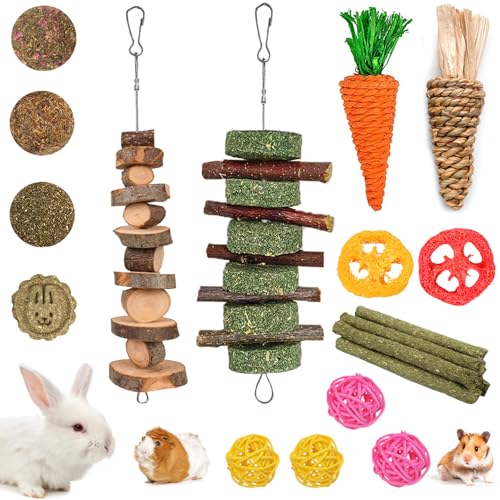







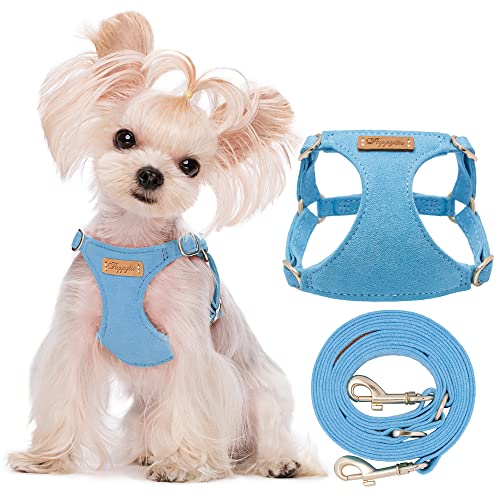
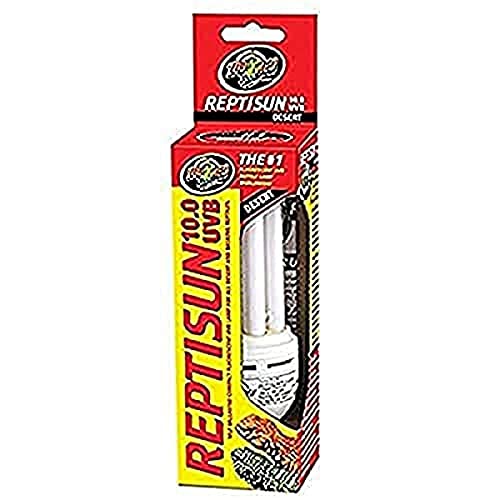
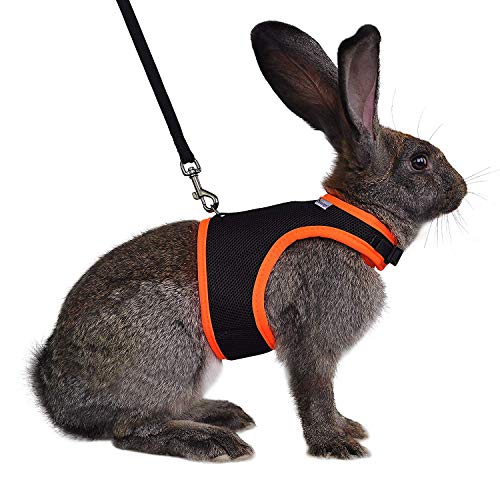
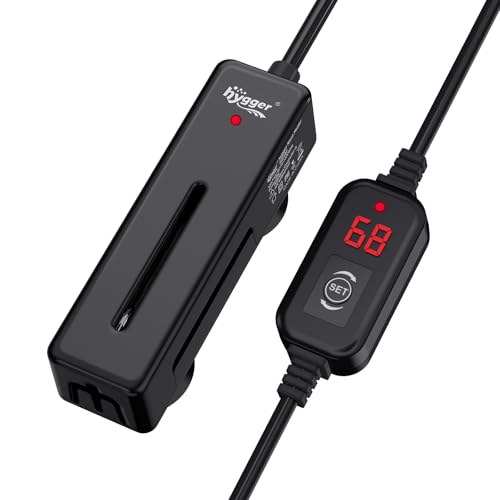
Bought a pack of these after reading the review — good call.
My bunny absolutely loved the timothy sticks first day, then moved on to the apple wood.
I rotate a couple a week so nothing gets boring.
They arrived intact and smelled faintly of wood, which I expected.
If you have more than one small pet, this 20-pack is actually very handy.
Thanks for the report, Emily — glad to hear the rotation worked. The expert verdict mentioned rotation as a benefit for enrichment, so your approach aligns well with that.
Nice! I keep mine in a zip bag to preserve the scent a bit longer, seems to help.
Zip bag is a good idea — I just toss extras in a drawer and they stay fine for weeks.
Does anyone know if these are safe for hamsters? The listing mentions small animals but I want to double-check.
The product targets small-animal pets and is commonly used for hamsters, guinea pigs, and rabbits. Just avoid giving very large chunks to tiny hamsters and supervise initially to check for any small splinters.
Article score of 8.4 seems fair. You get a lot for under $10 but don’t expect gourmet pet toys.
Would recommend for casual buyers and people who like natural materials.
I second that — good balance of cost and utility.
Exactly. If you want artisan toys, spend more, but for everyday replacement these are great.
Agreed — it’s a value pick with practical benefits. The rating factors in price, materials, and variety.
My hamster gave me the side-eye when I brought these out like: ‘Oh good, more wood, said no hamster ever.’ 😂
But then he chewed them all day. Guess he was sarcastic.
Glad your hamster came around! Small animals can be surprisingly picky — the variety in the 20-pack helps find a favorite.
Haha that made me laugh. Pets: 0 expectations, 100% mystery.
Decent for the price. My chinchilla chewed through the smaller sticks in a day, but for $10 I don’t mind restocking.
I have mixed feelings. Shipping was fast from Amazon and the price is great ($9.99), but a chunk of one stick broke off and I had to toss it.
Positive: natural, inexpensive, variety is excellent.
Negative: inconsistent piece strength, occasional dust.
If you rotate them and supervise new ones, you should be fine.
Maybe they’re secretly testing our patience. ‘Will the human notice?’
Thanks, Ethan. Your experience mirrors the expert verdict — great value but monitor for occasional weak pieces.
Good safety reminder — remove small fragments immediately and do size checks for very small pets. We recommended supervision in the article for that reason.
Anything to avoid choking hazards? My hamster sometimes tries to swallow bits.
I cut bigger sticks into smaller safe sizes to prevent swallowing — works well for me.
Long post — sorry, I get carried away. But here’s my experience:
My guinea pig loved the timothy sticks but ignored the apple wood for days.
I eventually tied a few together and made a little hanging chew toy — instant interest.
If you’re crafty it’s fun to make different shapes, and the 20-pack gives you material to experiment with.
Also, price is unbeatable for trying new enrichment ideas.
Thanks for the creative tip, Hannah — making hangers from the pieces is a clever enrichment hack. We loved that idea in the comments section of the article.
Hemp twine is the way to go. No metal parts = safer.
I used natural hemp twine — soft and easy to replace.
Ooh hanging toy idea noted. Did you use string or wire? I worry about the wire poking them.
Surprisingly durable for the price. My chinchilla only likes the apple wood, so having 20 pieces means I don’t have to reorder every week.
Happy to hear it’s working for your chinchilla! The article highlighted variety as a major plus, especially for choosy chewers.
I ordered these for my pair of dwarf rabbits and I’m pretty impressed.
Pros: cheap, natural wood, lots of pieces to rotate.
Cons: some pieces are softer than others and a few splintered after heavy nibbling.
I cut the sharp bits off and they were fine — just keep an eye on the little ones.
Overall I’d buy again because my buns prefer them to store-bought ‘flavored’ toys.
Another useful tip — sanding or trimming rough spots is an easy way to increase longevity and safety.
Which pieces splintered for you? The apple wood or the grass sticks?
I sanded a couple rough edges lightly with sandpaper and it made them safer for my guineas.
Good to know. I’ll keep sandpaper handy when mine arrive!
Thanks for the safety note. We did mention monitoring for splinters in the review — natural wood can vary. Good call trimming sharp bits.
Mostly the thinner grass/timothy sticks — the apple wood was sturdier.
I ordered this hoping it would be fine for my hamsters and gerbil. A few thoughts:
– Some pieces are large and need to be cut down.
– Watch for loose fibers on the grass sticks.
– Great for dental wear but supervise early on.
Wouldn’t recommend leaving a bunch unattended with very small pets until you know which pieces are safe.
I bundled smaller bits together to avoid loose fibers — helped with the gerbil.
Good call on cutting. I use kitchen scissors and it’s quick.
I cut and sand pieces down for my dwarf rabbit. Takes a minute and is worth the safety.
Solid, practical advice — supervision and sizing are key for tiny pets. We mention size considerations in the product specs and target audience notes.
Quick thumbs up — cheap and my rabbit prefers these over alfalfa blocks. No more bored buns!
Does anyone else notice a faint apple smell with the apple wood ones? Mine do, in a pleasant way. 🍏
Also curious about longevity — mine lasted about 2 weeks under heavy use before needing replacement.
Yeah my rabbit liked the apple ones more too. Smell definitely helped.
The apple wood can have a mild scent which some pets find attractive. Lifespan depends on chewing intensity — the review noted variable durability across pieces.
Packaging was kinda plain and a few pieces were dustier than I expected.
Quality overall seemed ok but not premium.
For people expecting handcrafted-looking toys, this might be disappointing.
However, my rabbit still favored them over the plastic toys he had before.
So: functional, affordable, not fancy.
Not premium, but my guinea pig dug the texture. Worth it if you prioritize natural materials over looks.
Good point about packaging — the manufacturer focuses on natural, low-cost materials, which can mean simpler packaging. We noted the same in the review’s specs.
I had the same dust issue, gave them a quick wipe and all good. Natural wood will have small chips sometimes.
Agree on rinsing. I also microwaved one stick for 10 seconds (careful!) to kill any surface germs — seemed to help.
If anyone is concerned about dust, a gentle rinse and full drying cycle is usually fine before giving to pets.